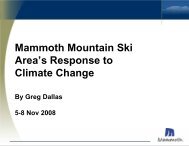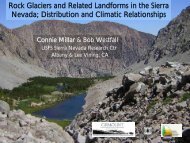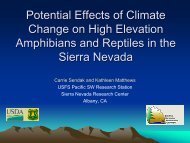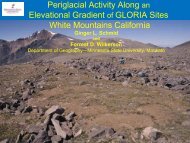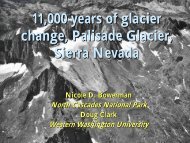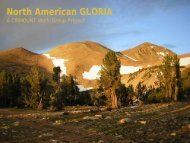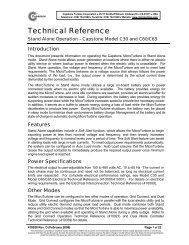alpine meadows, sierra nevada bighorn sheep, and wilderness
alpine meadows, sierra nevada bighorn sheep, and wilderness
alpine meadows, sierra nevada bighorn sheep, and wilderness
Create successful ePaper yourself
Turn your PDF publications into a flip-book with our unique Google optimized e-Paper software.
ALPINE MEADOWS AND SIERRA NEVADA<br />
BIGHORN SHEEP: WILL CLIMATE CHANGE<br />
IMPACT RECOVERY?<br />
Tom Stephenson, Lacey Greene, Mike Dodd,<br />
Lora Konde, <strong>and</strong> John Wehausen
Original Distribution of Sierra Nevada Bighorn Sheep
Current Distribution of Sierra Nevada Bighorn Sheep<br />
A. Lawrence
Kern<br />
Central<br />
Southern<br />
Northern<br />
160<br />
140<br />
120<br />
100<br />
80<br />
60<br />
40<br />
20<br />
0<br />
Current Estimate Goal<br />
Number of adult ew
Kern<br />
6<br />
5<br />
4<br />
3<br />
2<br />
1<br />
0<br />
Current Estimate Goal<br />
Central<br />
Southern<br />
Northern<br />
Number of herd un
160<br />
0<br />
1975 1980 1985 1990 1995 2000 2005<br />
EWES<br />
140<br />
120<br />
100<br />
80<br />
60<br />
40<br />
20<br />
Baxter, Bubbs,<br />
& Sawmill<br />
Total<br />
Williamson<br />
Langley<br />
Wheeler<br />
listing<br />
Mono Basin
Threats to Recovery<br />
• Small Population Size<br />
– Demographic concerns (e.g., Allee effect)<br />
– Genetic concerns (e.g., inbreeding<br />
depression)<br />
• Climate<br />
• Habitat/Forest Succession<br />
• Predation<br />
• Disease
Climate Change Predictions<br />
• Decline in <strong>alpine</strong><br />
meadow communities<br />
• Tree-line is expected<br />
to rise in elevation<br />
Lenihan et al. 2003. Ecol. Appl.
Shrinking Glaciers <strong>and</strong> Snowfields<br />
km2<br />
70<br />
60<br />
50<br />
40<br />
30<br />
20<br />
10<br />
0<br />
1900 2004<br />
• Basigic documented a<br />
decline in the<br />
coverage of glaciers<br />
in the Sierra Nevada<br />
of almost 50% during<br />
the past century<br />
Basagic 2008. MS Thesis
Diet Quality among regions<br />
1.5<br />
Diet Quality (ln% fecal N)<br />
1<br />
0.5<br />
N AK N BC AB SN, CA WM, CA<br />
0<br />
J F M A M J J A S O N D<br />
Date
Availability of Meadows within Herd<br />
Units<br />
Mt. Warren<br />
Mt. Gibbs<br />
Wheeler<br />
Ridge<br />
Mt. Langley<br />
2%<br />
0.8%<br />
0.9%<br />
0.3%
Mt. Gibbs
Delineation of Meadows
Plot of Bighorn Locations
Use by larger populations<br />
• Greater selection<br />
during autumn<br />
• If <strong>meadows</strong> senesce<br />
early, nutrient<br />
availability will decline<br />
during pre-winter<br />
foraging that is<br />
important for fat<br />
deposition
Use by smaller populations<br />
• Gibbs exhibited<br />
strong selection<br />
– Meadows are at the<br />
core of their range<br />
• At Warren, apparent<br />
avoidance may be a<br />
function of low<br />
availability in the core<br />
of the range
Conclusions<br />
• Sierra <strong>bighorn</strong> populations are small<br />
relative to historic levels.<br />
• We hypothesize that as populations grow<br />
<strong>and</strong> exp<strong>and</strong>,<strong>meadows</strong> will become more<br />
essential for supporting larger populations.<br />
• Meadows on the periphery of some ranges<br />
may have yet to be discovered.<br />
• Importance of <strong>meadows</strong> may vary among<br />
granitic <strong>and</strong> metamorphic ranges.
12,000’<br />
5,000’
Prescribed Fire
Bighorn Use of Burns
Acknowledgements<br />
• CDFG<br />
• USFWS<br />
• BLM<br />
• Kathleen Knox<br />
• Dave German



